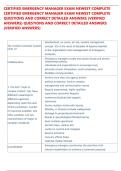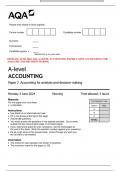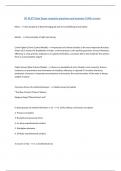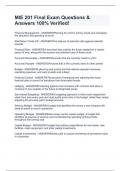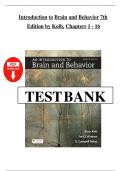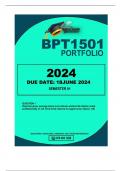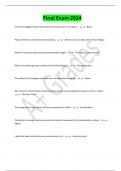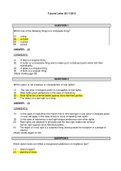Laura van den End
Adaptive and stress physiology
———————————————————————————————————————————-
Temmerman
———————————————————————————————————————————-
1. Hypoxia causes in animals an increase in oxygen binding capacity of haemoglobin
• False
• lowlander → to high altitude they increase the Hb capacity to deliver O2 to the right places = lowering affinity.
• Highlanders are adapted to hypoxic conditions and have an elevated [RBC] (bc of HIF-1 that promotes EPO
production)→ they have more Hb and have a greater carrying capacity of O2. They did not, however, increase
the affinity if Hb itself.
2. Hans Seyle could agree with the concept of hormesis
• True
• Hormesis: phenomenon that something that is bad for you in high dose, can be good for you in a low dose. It
keeps the body alert without exhausting it ~ eustress
• Seyle: founder of the general adaptation syndrome: consists of 3 phases: alarm, resistance and exhaustion →
describes the negative effects of chronic stress
• In the alarm phase, the stressor is noticed and the body experiences some shock → induces the fight or
flight response
• The sympathetic NS is active and cortisol and A levels rise (produced by adrenal gland, stimulated
by ACTH from pituitary gland after stimulus of CRH and VP from the hypothalamus = HPA axis of
neuron-adrenal response)
• In the resistance phase, de body stays focussed on dealing with the stressor (outside appearance is
normal, though recourses are used extensively)
• Parasympathetic NS is active and the levels of cortisol and A remain high → HR, BP and breathing
remain high
• The exhaustion phase occurs when the resistance phase takes too long or a new stressor induces a new
alarm phase without the time to recover from the first one. The recourses are depleted and the body is
e.g. more susceptible for diseases → can result in death if unresolved
• While Selye's emphasis was on the damaging effects of stress, he acknowledged the existence of adaptive
responses and the potential for beneficial effects in certain situations ~ in line with hormesis.
3. Hans Seyle zijn model bestaat uit drie fasen. →True (see Q2)
4. De hypoxia response kan ook in normoxia worden uitgelokt
• True
• Normoxia: O2 levels of the environment are normal for the animal - differs between diff species that live in diff
environments
• Hypoxia-inducible factor 1 (HIF-1) controls activation of hypoxia-sensitive genes
• Epo → stimulate RBC production
• VGEF → growth capillaries → more supply to tissues
• Glycolytic enzymes → more E without the need for O2
• HIF-1 is regulated:
• ↑[O2]: HIF-α is ubiquitinated by PHD → O causes hydroxylate cysteine branch of the response →
degradation by proteasome (happens in normoxia)
• At ↓[O2], harder for PHD to get by → HIF-α escapes hydroxylation → moves into nucleus to act TF →
promotes O2 response at genome level (happens in hypoxia)
• When HIF-1 is degraded in normoxic conditions, a feedback mechanism can occur where this degradation is
inhibited → hypoxic response
Adaptive and stress physiology — Examenvragen— 1/8
, Laura van den End
5. Vascular rete structure help actively moving animals retain heat. (Rate mirabile)
• True
• The vascular rete: countercurrent heat exchange system, a network of blood vessels found in animals that are
adapted to cold environments → conserve heat and prevent excessive heat loss.
• Warm arterial blood and cool venous blood flow in close proximity to each other, allowing for heat transfer
between the two.
• The warm arterial blood coming from the body core transfers heat to the cool venous blood returning from
the extremities → conserve body heat + keep vital organs warm
• Beneficial for actively moving animals (like some fish) because their increased muscle activity generates heat,
which can be lost through the limbs or extremities
6. The actogram of a per0 mutant would look the similar to that of a fruit fly kept in constant darkness.
• False
• per (period) gene: involved in the regulation of circadian rhythms in fruit flies. Per0 mutant → loss of circadian
rhythmicity.
• Actogram: shows activity of circadian rhythms (every 20-24h → activity after a cue (light))
• Circadian clocks have the characteristic that they run endogenously (without a cue). Taking away the cue has
the effect of a short or long running clock, where the activity occurs earlier or later resp. ≠ losing rhythmicity
• Losing rhythmicity can be caused by presenting the cue all the time
7. The concept of hormesis says that it is good that your tissues suffer from damage.
• False
• Hormesis: phenomenon that something that is bad for you in high dose, can be good for you in a low dose. It
keeps the body alert without exhausting it ~ eustress
• In this state the body is alert but not suffering
8. Seals can tolerate lactate so they can dive longer but they have to take a longer recuperation time.
• False
• Seals can not tolerate lactate
• In longer dives, the aerobic metabolism depletes O2 reserves → HIF-1 stimulates glycolysis → lactate
production
• [Lactate]↑ in longer dives when resurfacing → need to get rid off in the local muscles → into the blood so that
the entire body can detoxify → convert again into pyruvate and into the Krebs cycle (O2 is available again)
• The longer the dive, the longer the recovery → efficient to stay below the ADL (aerobic diving limit)→ able to be
longer under water in the long run
9. A human with non-functional melanopsin will deal with negative health conditions.
• True
• Light comes in through eyes (even when blind) → not by rods and cones but by retinal ganglion cells: some are
photo-sensitive → have their own opsin: melanopsin → plays a role in synchronizing the internal clock with the
ext light-dark cycle
• When the melanopsin is non-functional, light perception is decreased and the person will experience a more
dark/dark cycle which can result in seasonal affective disorder (SAD); mutation: pro10leu.
10. Thermoregulators always use more energy than thermoconformers.
• True
• Conformers: match inter and external environment, typically small animals without exoskeleton
• Regulators: internal environment remains constant, is very energy-costly, typically large animals
• Though all kind of combinations can be made
Adaptive and stress physiology — Examenvragen— 2/8
Adaptive and stress physiology
———————————————————————————————————————————-
Temmerman
———————————————————————————————————————————-
1. Hypoxia causes in animals an increase in oxygen binding capacity of haemoglobin
• False
• lowlander → to high altitude they increase the Hb capacity to deliver O2 to the right places = lowering affinity.
• Highlanders are adapted to hypoxic conditions and have an elevated [RBC] (bc of HIF-1 that promotes EPO
production)→ they have more Hb and have a greater carrying capacity of O2. They did not, however, increase
the affinity if Hb itself.
2. Hans Seyle could agree with the concept of hormesis
• True
• Hormesis: phenomenon that something that is bad for you in high dose, can be good for you in a low dose. It
keeps the body alert without exhausting it ~ eustress
• Seyle: founder of the general adaptation syndrome: consists of 3 phases: alarm, resistance and exhaustion →
describes the negative effects of chronic stress
• In the alarm phase, the stressor is noticed and the body experiences some shock → induces the fight or
flight response
• The sympathetic NS is active and cortisol and A levels rise (produced by adrenal gland, stimulated
by ACTH from pituitary gland after stimulus of CRH and VP from the hypothalamus = HPA axis of
neuron-adrenal response)
• In the resistance phase, de body stays focussed on dealing with the stressor (outside appearance is
normal, though recourses are used extensively)
• Parasympathetic NS is active and the levels of cortisol and A remain high → HR, BP and breathing
remain high
• The exhaustion phase occurs when the resistance phase takes too long or a new stressor induces a new
alarm phase without the time to recover from the first one. The recourses are depleted and the body is
e.g. more susceptible for diseases → can result in death if unresolved
• While Selye's emphasis was on the damaging effects of stress, he acknowledged the existence of adaptive
responses and the potential for beneficial effects in certain situations ~ in line with hormesis.
3. Hans Seyle zijn model bestaat uit drie fasen. →True (see Q2)
4. De hypoxia response kan ook in normoxia worden uitgelokt
• True
• Normoxia: O2 levels of the environment are normal for the animal - differs between diff species that live in diff
environments
• Hypoxia-inducible factor 1 (HIF-1) controls activation of hypoxia-sensitive genes
• Epo → stimulate RBC production
• VGEF → growth capillaries → more supply to tissues
• Glycolytic enzymes → more E without the need for O2
• HIF-1 is regulated:
• ↑[O2]: HIF-α is ubiquitinated by PHD → O causes hydroxylate cysteine branch of the response →
degradation by proteasome (happens in normoxia)
• At ↓[O2], harder for PHD to get by → HIF-α escapes hydroxylation → moves into nucleus to act TF →
promotes O2 response at genome level (happens in hypoxia)
• When HIF-1 is degraded in normoxic conditions, a feedback mechanism can occur where this degradation is
inhibited → hypoxic response
Adaptive and stress physiology — Examenvragen— 1/8
, Laura van den End
5. Vascular rete structure help actively moving animals retain heat. (Rate mirabile)
• True
• The vascular rete: countercurrent heat exchange system, a network of blood vessels found in animals that are
adapted to cold environments → conserve heat and prevent excessive heat loss.
• Warm arterial blood and cool venous blood flow in close proximity to each other, allowing for heat transfer
between the two.
• The warm arterial blood coming from the body core transfers heat to the cool venous blood returning from
the extremities → conserve body heat + keep vital organs warm
• Beneficial for actively moving animals (like some fish) because their increased muscle activity generates heat,
which can be lost through the limbs or extremities
6. The actogram of a per0 mutant would look the similar to that of a fruit fly kept in constant darkness.
• False
• per (period) gene: involved in the regulation of circadian rhythms in fruit flies. Per0 mutant → loss of circadian
rhythmicity.
• Actogram: shows activity of circadian rhythms (every 20-24h → activity after a cue (light))
• Circadian clocks have the characteristic that they run endogenously (without a cue). Taking away the cue has
the effect of a short or long running clock, where the activity occurs earlier or later resp. ≠ losing rhythmicity
• Losing rhythmicity can be caused by presenting the cue all the time
7. The concept of hormesis says that it is good that your tissues suffer from damage.
• False
• Hormesis: phenomenon that something that is bad for you in high dose, can be good for you in a low dose. It
keeps the body alert without exhausting it ~ eustress
• In this state the body is alert but not suffering
8. Seals can tolerate lactate so they can dive longer but they have to take a longer recuperation time.
• False
• Seals can not tolerate lactate
• In longer dives, the aerobic metabolism depletes O2 reserves → HIF-1 stimulates glycolysis → lactate
production
• [Lactate]↑ in longer dives when resurfacing → need to get rid off in the local muscles → into the blood so that
the entire body can detoxify → convert again into pyruvate and into the Krebs cycle (O2 is available again)
• The longer the dive, the longer the recovery → efficient to stay below the ADL (aerobic diving limit)→ able to be
longer under water in the long run
9. A human with non-functional melanopsin will deal with negative health conditions.
• True
• Light comes in through eyes (even when blind) → not by rods and cones but by retinal ganglion cells: some are
photo-sensitive → have their own opsin: melanopsin → plays a role in synchronizing the internal clock with the
ext light-dark cycle
• When the melanopsin is non-functional, light perception is decreased and the person will experience a more
dark/dark cycle which can result in seasonal affective disorder (SAD); mutation: pro10leu.
10. Thermoregulators always use more energy than thermoconformers.
• True
• Conformers: match inter and external environment, typically small animals without exoskeleton
• Regulators: internal environment remains constant, is very energy-costly, typically large animals
• Though all kind of combinations can be made
Adaptive and stress physiology — Examenvragen— 2/8


